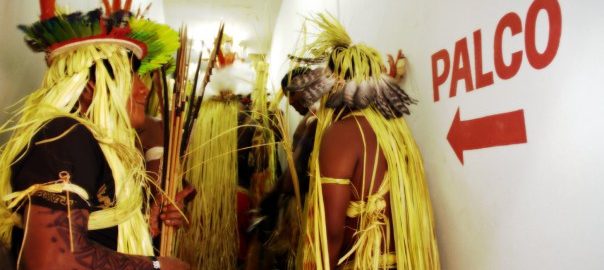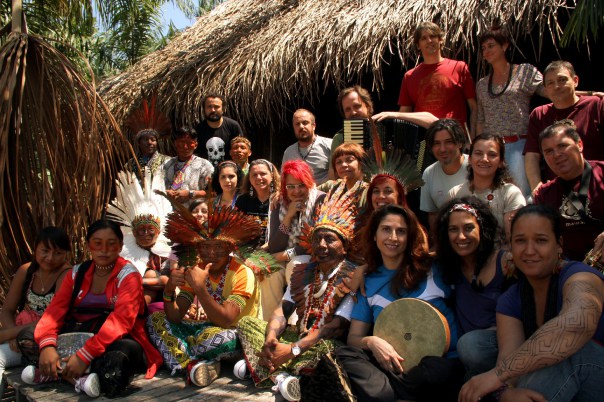The indigenous people in Brazil are largely seen as exotic creatures. There are Indians who adapted to modern civilization. But those how live remotely want to maintain their identity. They fight for their rights as you can read in the article about Belo Monte. Modern people tend to see their life style as the only right one. But why not learn from the indigenous? This is what the music group Mawaca coming from São Paulo did. They not only learned songs from them but they had a true musical exchange. In this article (including the documentary Mawaca – Cantos da Floresta) Brazilian journalist and photographer Eduardo Vessoni gives a report of Mawaca’s encounter with six indigenous groups in 2011.
by Eduardo Vessoni, translated to English by Rita Braga
History repeats itself every time one more foreign group lands at Manaus airport. Luxury lodge accommodations deep down in the forest, superficial hangouts to riverside communities and visits to humble communities where native indigenous wear indigenous costumes to welcome another surprised tourist group that fill their shopping bags with local handcraft.
However, the most coveted forest on the planet can give other shades to the rhythm of those who come to those lands once they are inclined to learn about this Brazil that does not usually unfold on tour brochures nor on cinematographic works that insist on portraying it in an embarrassing way. Few people know of it (or had the chance to see firsthand), but that green area, over 7 million square kilometers, hides a unique world, from which only those who go far (and deep) enough will bring stories that nourish their eyes and soul.
In a small, plain hotel room in Ji Paraná, 374km for the capital of Rondônia state, Porto Velho, seven female singers of Mawaca look into indigenous lyrics that fit to the sounds played by the musicians of the band. On the following days, the group Mawaca and six indigenous groups, spread over three states of the North region of Brazil, will lead an encounter that had seemed impossible. Musicians and indigenous will gather in workshops and public concerts whose set lists include songs and minimal beats from those people who would only make headlines when they fought for land or on (stereotyped) chapters of school history books.
1. Ikolen-Gavião
Surrounded by the atmosphere typical of the moments just before stepping on stage, those men, who speak smoothly, come subtly to prepare the flutes known as gõan-ey, an instrument that has a strong sound, made of large bamboos and that is played for the water spirit in the rainy seasons. Ornamented with straw, those winds work as an extension of the Ikolen men bodies and its use remains through generations. Little by little, the yellow shade of that natural material, of which this short-lasting instrument is made, starts to share space with the red from the “urucum” that tints those bodies appearing, naturally, created with cinnamon powder. More than the allegoric effect, the paintings are like an outfit to the indigenous who, with pride, show off on ritual days or for musical presentations.
Intermittent applause from the audience at the end of the concert recognizes not only that group, but also all the indigenous people of the region. “I am ashamed to know that an ensemble from São Paulo must come all the way here to show us our own culture. Those who are from here cannot see their own indigenous roots”, describes Kátia Fernandes, one of the over 700 people who crowded the theater of a local club. The next stop is in Cacoal, at the Line 14 Village of the Paiter-Suruí.
2. Paiter-Suruí
The music circle that shapes up joining those musicians and those brave indigenous people materializes the dream of connecting distant traditions and contemporary arrangements. Anthropophagic chants like Koi Txangaré are uttered to the sound of brass and percussion instruments; “curumins” (indigenous children) find out new sounds from Chinese winds and frames brought by the musicians; and “caxixis” (ordinary Brazilian shaker) becomes an attraction in that open-air theater surrounded by tall buildings made of straw.
Situated on the border between Rondônia and Mato Grosso states, the Suruí live in places know as ‘line’, a reference to the demarcation of lands during the colonization processes in the region. The Suruí call themselves “Paiter”, which mean ‘true people, ourselves’ in their local language. But when the foreigners arrive at that isolated bit of the Amazon, the reception is humble and warm. “This is an exchange of experiences between the two tribes: Suruí and Mawaca”, defines the well-articulated Uraan Suruí, a young man who starts to get interested in his people’s traditions. Uraan and all those people have endless willingness and curious looks that stare at the musical novelty.
3. Karitiana
Less numerous and having their historic memory altered by strong influences of the ‘white people’ culture, like evangelical worship, the Karitiana are the characters of the next destination, Porto Velho. The still unknown past of these people, whose records date from the first half of the 20th century, is kept by a population of a bit more than 300 people who live in the Karitiana village, near the capital of Rondônia state. Located 100km from Porto Velho, the place can still be reached by an earth road, but it begins to lose its characteristics as brick and cement houses start to be raised, as well as other constructions that work as churches which, according to the Karitiana themselves, are the ‘House of God’.
In front of that ethnic group that still segregate men and women when it is time to sing, Mawaca breaks paradigms and fuses, on the same stage multiple tone female vocals and the low, melodic chant of the few Karitiana who showed up for the following concert. Naked indigenous men at riverside, obedient women taking care of their chores, and children running from and to their “ocas” (straw shelters) are no longer part of their routine. For years, they haven’t been what we once heard in the naive stories told to us in our childhood. A visit to the Amazon forest can be a trip not only for the body, but also for the soul. And this journey takes hallucinating paths, literally, when followed by the next leading characters: the Kaxinawá.
4. Kaxinawá
When Mawaca launched ‘Rupestres Sonoros’ CD (2007), which takes the inroad to the indigenous musical world and connects it to the rupestrian art, the members of the groups could not imagine the ways they would trace later. It was in that meeting with the Kaxinawá that the story about musical archeology and ancestor images began to make sense for those musicians, who had not yet been given the opportunity to maintain such close contact with the author of those chants. Right when the group began to show signs of exhaustion and the indigenous cultural expressions started to repeat itself, there came the Kaxinawá.
Little by little, those bold men in meticulously made adornments and impressive body paintings made with jenipapo (fruit) and urucum (seed) started to appear from the middle of the trees in a green area that belongs to an NGO in Rio Branco, where the meeting was going to take place. They are discreet, quiet, and walk as slowly as the waters of the river that had brought them to the capital of the state of Acre, a journey that had begun three days before, at the border with Peru.
Still, the Huni Kuin, as they are also called, can strike one of the greatest impacts of the whole trip. After the first meeting, an upbeat conversation about their looks with cockades of great dimensions and their body paintings making reference to animals, the group shared some grayish powder to the musicians. Shamanic, the Kaxinawá are known not only for the use of “ayahuasca” during events known as ‘vine ritual’, but also for the use of “rapé” (snuff), a mix of Amazon herbs, tobacco and ashes from a certain balm. More than remedy used in healing rituals, “rapé” is a means to expand the mind and attract good energy.
Those exploiting excursions through the spiritual world usually cause different reactions in the ones who use “rapé”. Nausea, headache, feeling of extreme happiness are some of them. However, when that indigenous group, with their penetrating eyes, start to utter Matsã Kawã, Kaxinawá song used in ‘visualization’ rituals, the visitors start to sit, silently, and have one of the most introspective experiences of all trip. From then on, each one of those musicians take the route of a unique journey that only the Amazon could stage. The last destination of the musical expedition was in the most famous state of that jungle region: Amazonas
5. Bayaroá
The first visit was to the Bayaroá group, a commune of several remaining peoples like Tukano, Tuyuka, Bará, Desana and Tariana. Located in the outskirts of Manaus, the group still preserves some habits like the drawings with “crajiru”, medicinal plant that is used for body paintings, the use of winds in musical performances and a deep awareness of their past perpetuation. In indigenous language, “bayaroá” means ‘master of dance and rituals’. Executing rhythmic movements and playing sounds from long tube winds, resembling Eastern flutes, they starred something unprecedented: the first indigenous performing group at Amazonas Theater, architectural and cultural symbol of the region. That majestic construction erected at the end of the 19th century for the aristocracy of the rubber economic cycle would now stage an unlikely performance in those lands that seem to have erased their indigenous past.
6. Omágua
Manacapuru, 84 kilometers from Manaus, to the left of the Solimões river, marked the end of the journey. The arrival to the Kambeba community is made in a simple tree trunk canoe, crossing the local stream. “We feel that this is like an isolated island of pure water. That world there remained detached from this world here”, describes Marlui Miranda, singer specialized in indigenous sounds who was also on Mawaca’s tour. Traditional, those people also known as “Omágua”, surprise us with their interest in the instruments of the band and even ask Mawaca to make arrangements for their songs. The children still play from and to the “malocas” (indigenous houses), sound horns made of bamboo are played when the foreigners arrive and chants keep being sung within the community, although many of them have clear influence of the hymns played in evangelical churches.
At the time I was on Mawaca’s tour as a journalist, I used to wear dreadlocks on my hair (orange and green, to be more specific). What should have been the curiosity of white people about that barely known culture would turn out to be the curiosity of indigenous people about those people coming from far away, with their colored hair and odd clothes. While I went uphill on the way back the bus that waited for the group’s return, a little indigenous boy shouted while I passed by a simple brick house: “There comes the man with the sweater wool hair”. I could never have thought of a more precise and detailed definition about mere Rasta style hair.
Mawaca’s performace with the Kambeba at Ingá Park, would mark the end of that experience in the Amazon territory. And more than a deep dive into indigenous sounds, it was an emotional journey with a beginning date, but no time to end.
Here you can find this account in Portugues including more photos.


Is the original culture still preserved there until now?
Yes, there are protected areas where the original culture is preserved, but that doesn’t mean that they don’t adept to modern times.